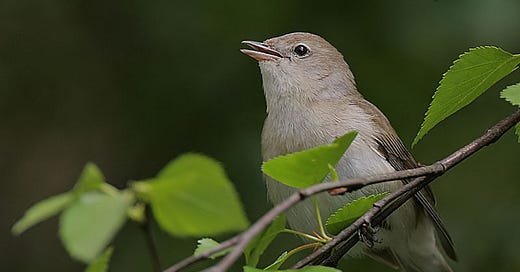Imagine being told that your only distinguishing visual feature is that you have no distinguishing visual features. Hurtful stuff.
But it’s quite a useful guide when applied to the garden warbler. On first look they appear to be an unfinished model of ‘generic bird’, to which interesting eye stripes, wing bars and a dash of colour are yet to be applied.
However, like the nightingale, garden warblers hardly need bother with visual aesthetics because they have a wonderful song. And each Spring thousands of us will cock our ears to it while asking ourselves: ‘Is that a blackcap?’
Garden warblers and blackcaps sound very much alike. Both make a rapid rushing warble, often from thick cover.
The garden warbler has a reputation as the slightly less accomplished of the two.
With sustained listening, we can notice that it lacks the flutey variation of the blackcap, being buzzier and more babbling. While blackcaps tend to be dramatic and brief, garden warblers are chattier and can go on a bit.
Another useful clue is the difference between their alarm calls. Blackcaps have a sharp ‘tak!’ that they throw in freely between bursts of song, whereas garden warblers have a raspier ‘chet’, that to my ear has something of the chicken about it.
Garden warblers are also rather poorly named in the English language. They’re unlikely to be found in anything other than the biggest and most rambling of gardens, as their preferred habitat is thick scrub and coppiced woodland.
These are the groves to which they return in late April, and from where they will sing until midsummer, before quietly disappearing back south to Africa in the early autumn.
Unlike their blackcap cousins, they have not developed a taste for British winters or garden bird feeders, but in southern Europe they are known for their love of ripe figs; indeed they’re are called ‘fig warbler’ in Portugal. And in late summer they may be found with the purple juice staining the feathers around their bill, which is one way to add that dash of colour.
If you’d like to tune your ears to the birds this Spring, you can join me for British Birdsong Essentials beginning next week.
This five-week course focuses on equipping you with the knowhow to recognise more than 25 common resident and summer songbirds by sound, with podcast-style audio lessons, identification support throughout, three group practice / Q&A sessions via Zoom and ongoing access to exclusive online species guides for more than 60 resident and summer-visiting species.
Find out more on the Birdsong Academy website.
Media credits: Image by Steve Garvie reproduced under Creative CommonsAttribution-Share Alike 2.0 Generic license.



